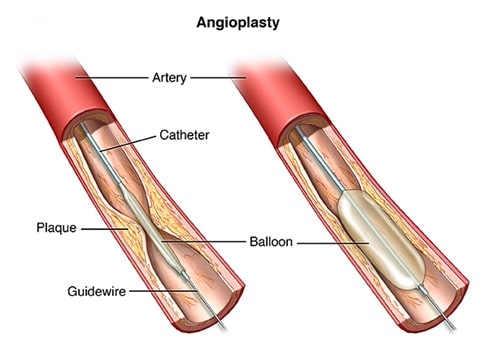What is Coronary Angioplasty?
Angioplasty is a procedure in which a balloon is used to stretch open a narrowed or blocked artery. However, most modern angioplasty procedures also involves inserting a short wire-mesh tube, called a stent, into the artery during the procedure. The stent is left in place permanently to allow blood to flow more freely.
Coronary Angioplasty is sometimes known as percutaneous transluminal coronary angioplasty (PTCA). The combination of coronary angioplasty with stenting is usually referred to as percutaneous coronary intervention (PCI). A catheter is a thin, flexible tube which is inserted into a coronary artery. The balloon at the tip of the catheter is blown up at the narrowed section of artery to force it wider. A small tube (a stent) is left in place to keep the artery widened.

When a coronary angioplasty is used?
Like all organs in the body, the heart needs a constant supply of blood. This is supplied by the blood vessels called the coronary arteries. In older people, these arteries can become narrow and harden (known as atherosclerosis), which can further cause coronary heart disease.If the flow of blood to the heart is restricted, it can lead to chest pain known as angina, which is usually triggered by physical activity or stress.While angina can often be treated with medication, a coronary angioplasty may be required to restore the blood supply to the heart in severe cases where medication is ineffective. Coronary angioplasty are often done as an emergency treatment after a heart attack.
What are the benefits of a coronary angioplasty?
In most cases, the blood flow through the coronary arteries improve after an angioplasty procedure. Majority of people hardly find any symptoms they had earlier post surgery and they’re able to do more physical activities than they could before. If you’ve had an heart attack, an angioplasty can increase your chances of surviving more than in a clot-busting medication (thrombolysis) and the procedure can also reduce your chances of having another heart attack in the future.
How a coronary angioplasty is performed?
A coronary angioplasty is performed using local anesthetic, which means you will be awake while the procedure is carried out. During an angioplasty, a thin, flexible tube called a catheter will be inserted into one of your arteries through an incision in your groin, wrist or arm. This will be guided to the affected coronary artery using a continuous X-ray video. When the catheter is in place, a thin wire is guided down the length of the affected coronary artery, over which a small balloon will be delivered to the affected section of the artery. This is then inflated to widen the artery, squashing fatty deposits against the artery wall so that blood can flow through it more freely when the deflated balloon is removed. If a stent is being used, this will be provided ready-prepared around a balloon before it’s insertion. The stent will expand when the balloon is inflated and it will remain in place when the balloon is deflated and removed. A coronary angioplasty usually takes between 30 minutes and two hours depending upon the case. If you are being treated for angina, you will normally be able to go home later the same day or the day after you had the procedure, but you will need to avoid lifting heavy weights, strenuous activities and driving for at least a week. If you have been admitted to hospital following a heart attack you may need to stay in the hospital for several days after the angioplasty procedure to recover completely from the heart attack before sent home.
How safe is coronary angioplasty?
Coronary angioplasty is one of the most common types of treatment for the heart. Around 75,000 procedures are performed in England each year. Coronary angioplasty is most commonly performed in people who are above 65 years of age or older as they are more likely to have a heart disease. As the procedure does not involve making major incisions in the body, it is usually carried out safely in most people. Doctors refer to this as a minimally invasive form of treatment. The risk of serious complications from a coronary angioplasty is generally small, but this depends on multiple factors such as your age, general health and whether you have suffered a heart attack. Serious problems that can occur as a result of the procedure include excessive bleeding, a heart attack and even a stroke.
